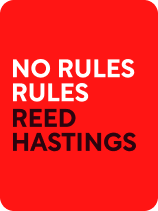

This article is an excerpt from the Shortform book guide to "No Rules Rules" by Reed Hastings. Shortform has the world's best summaries and analyses of books you should be reading.
Like this article? Sign up for a free trial here .
Are you looking for some No Rules Rules quotes? How are the main messages of the book about Netflix management captured in its key passages?
These No Rules Rules quotes highlight some of the main lessons from author and Netflix CEO Reed Hastings. These quotes from the book focus on performance, feedback, and autonomy.
Read on for three No Rules Rules quotes and what they mean.
Three No Rules Rules Quotes
“If you have a team of five stunning employees and two adequate ones, the adequate ones will sap managers’ energy, so they have less time for the top performers, reduce the quality of group discussions, lowering the team’s overall IQ, force others to develop ways to work around them, reducing efficiency, drive staff who seek excellence to quit, and show the team you accept mediocrity, thus multiplying the problem.”
The first of the No Rules Rules quotes is about performance. Performance—whether good or bad—is contagious. Hastings hadn’t realized that, before the layoffs, the mere presence of adequate employees had been dragging down the performance of his entire team. On a team of high performers, just one or two mediocre workers can have adverse effects:
- They reduce efficiency by forcing others to find ways of working around their less-than-stellar performance.
- They bring down the quality of group discussion.
- They take managers’ energy and attention away from top performers.
- They cause the team to produce lower-quality work, which causes some high-performing employees to quit out of frustration.
- Their presence sends a message to everyone else that company leaders condone mediocrity, which reduces motivation and performance across the board.
One study showed that a single low performer brings an entire team’s productivity down by 30 to 40 percent. In the experiment, college students were grouped in teams of four to perform a task in 45 minutes—but the students didn’t know that each team included an actor who was assigned to play the role of a jerk, a slacker, or a depressive pessimist. Regardless of the talents of the rest of the group, by the end of the session, each team had adopted the attitude of its bad apple: The jerk’s teammates were insulting each other, the slacker’s teammates had given up on the task, and the pessimist’s teammates had deflated and lay their heads down on their desks.
By contrast, as Hastings discovered, a team full of highly talented people pushes everyone’s performance up. Hastings vowed to hire only the best employees, and, in Chapters 4 and 7, we’ll discuss how he reinforced this principle by paying top dollar to keep great employees and training managers to identify and let go of anyone—from receptionists to executives—who fell below that standard. To cultivate the adaptive, innovative culture Netflix needed, Hastings created a high-performing workforce that provided the foundation for the following practices we’ll discuss. Next are two more No Rules Rules quotes, which would support high performance.
“I recommend instead focusing first on something much more difficult: getting employees to give candid feedback to the boss. This can be accompanied by boss-to-employee feedback. But it’s when employees begin providing truthful feedback to their leaders that the big benefits of candor really take off.”
The second of the No Rules Rules quotes is about feedback. Leaders should show how much they value feedback by being the first to receive it. This sets the tone for a candid environment, but it can still be intimidating for employees to critique their bosses. Managers can lower this barrier in two ways:
- In one-on-one meetings with employees, list “feedback” as an agenda item. This shows that you’re serious about soliciting critiques, and that employees’ candor is not only allowed, but expected.
- Respond to feedback in an open, appreciative way. For example, move closer physically, use a warm tone of voice, look into the employee’s eyes in a positive way, and thank the employee for her candor. These cues show the employee that it’s a safe environment to voice her opinions.
In addition to setting an example for openly accepting criticism, leaders often need to hear what their employees are thinking. The higher your position in an organization, the less feedback you typically receive, because colleagues are less likely to question an executive than a mid-level employee. Furthermore, the consequences of a manager’s error are typically greater than a junior employee’s mistake—the junior employee may flub a single project, while the manager could steer the company into a bad business deal. Leaders need their staff to let them know when they’re veering in the wrong direction.
“With my next company, Netflix, I hoped to promote flexibility, employee freedom, and innovation, instead of error prevention and rule adherence.”
The third of the No Rules Rules quotes is about autonomy and the Netflix culture of Freedom and Responsibility. The first critical business practice that Hastings established at Netflix—to hire and keep only the best employees—grew out of lessons he’d learned from a previous business failure and from a challenge in Netflix’s early days.
The first lesson was one he’d taken from the growth of his first company, Pure Software. In the first few years after the company’s founding in 1991, the culture was flexible and fun. The organization was still small enough that the employees enjoyed a great deal of freedom, whether that meant working from home or buying office equipment without purchase orders or approvals.
However, as Pure Software grew, it became more difficult to manage without implementing some controls. Every time an employee made a costly mistake, Hastings enacted a policy to prevent it from happening again. Soon, the formerly flexible startup culture had morphed into a rigid corporate environment. Hastings realized that the employees who thrived in rules-heavy workplaces were people who excelled at following protocol, rather than the innovators he needed to keep the company agile and successful. Ultimately, this led to Hastings’s downfall at Pure Software: When market needs changed, the company couldn’t adapt and Hastings was forced to sell the company to his competitor.

———End of Preview———
Like what you just read? Read the rest of the world's best book summary and analysis of Reed Hastings's "No Rules Rules" at Shortform .
Here's what you'll find in our full No Rules Rules summary :
- How Netflix achieved massive success in a short period of time
- The unusual business practices that have helped Netflix sustain its success
- Why Netflix fires adequate employees






